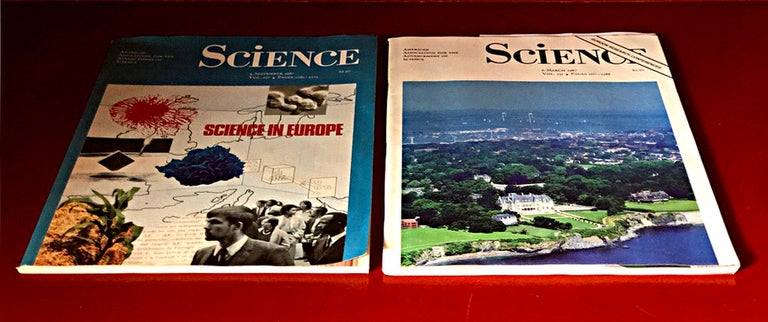The Resonating valence bond state in la-2CuO-4 and superconductivity (Anderson) in Science 235, pp. 1196-1198, March 6, 1987 WITH The discovery of a class of high-temperature superconductors (Bednorz and Müller) in Science 237, pp. 1133-1139, September 4, 1987
New York: AAAS, 1987. 1st Edition. TWO 1st EDITION PAPERS (in two separate issues, both in original wraps) OF IMPORT IN THE HISTORY OF SUPERCONDUCTIVITY, THE FIRST PROPOSING THE THEORY OF HIGH TEMPERATURE SUPERCONDUCTIVITY, AND THE SECOND CONTRIBUTING TO THE NOBEL PRIZE FOR ITS AUTHORS.
Working at Princeton and in this paper, the theoretical physicist Paul Anderson proposed the theory of high temperature superconductivity. This is distinct from the work of Bednorz and Müller who, a year earlier, discovered high temperature superconductivity – Anderson’s effort to lay the theoretical foundation for their discovery.
Anderson’s theory resonating valence bond theory (RVB) is an electron correlation based mechanism that “began as an insightful response by Anderson, to Bednorz and Muller's discovery of high Tc superconductivity in cuprates in late 1986” (Baskaran, Resonating Valence, Cornell, 2017). It develops “a theoretical framework for quantum spin liquids and superconductivity was developed [and] addresses a formidable strong coupling quantum manybody problem, in modern times. [Anderson’s theory] is built on certain key experimental facts: i) survival of a dynamical Mott localization in a metallic state, ii) proliferation of bond singlets and iii) absence of fermi liquid quasi particles” (ibid). In this paper, Anderson also discusses “superconductivity and the nature of excitations in the system” (Anderson, 1987).
“Superconductivity, one of the most spectacular phenomena of physics, has been known since 1911. Superconductivity arises when a superconducting material is cooled to a fairly low critical temperature. Suddenly, an electric current can then flow with no resistance whatsoever… It has been the dream of many researchers to find material that remains superconducting at higher temperatures but, in spite of small advances, nothing had happened since 1973, when an alloy was produced that became superconducting at -250°C.” (Nobel Prize Press Release).
In their 1986 paper, “Bednorz and Müller reported finding superconductivity in an oxide material at a temperature 12°C higher than previously known. This was the introduction to an explosive development in which hundreds of laboratories the world over commenced work on similar material. Better superconductors have already been produced” (ibid).
In this follow up paper, Bednorz and Müller describe the background and early development of high temperature superconductivity, writing “The exceptional interest in the new class of oxide superconductors and the importance of these materials are discussed together with the concepts that led to their discovery. The discovery itself and its early confirmation are summarized, including the work until the beginning of 1987. The observation of a superconductive glass state in percolative samples is also discussed” (Bernorz and Müller, 1987).
In the same year Bednorz and Müller won the Nobel Prize “for their discovery of high-temperature superconductivity in ceramics”, inclusive of both this paper and the initial 1986 paper (Nobel Prize Committee). Item #1243
CONDITION & DETAILS: New York: AAAS. Two 1st editions, each original pictorial wraps. 8vo. Neither issue has a mailing label. Both wraps have very slight surface toning on the wraps. Both are bright and exceptionally clean within. Near fine.
Price: $550.00

